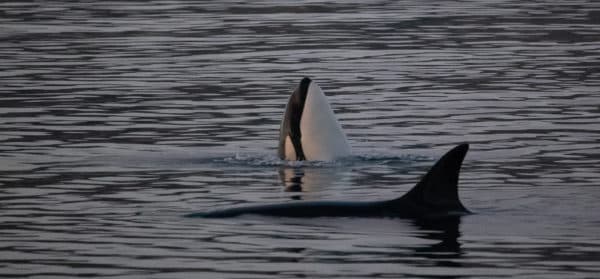Written by: Ryan Hou, Senior Naturalist
If you’ve ever been on tour with us, you would have noticed that we know LOTS about the whales in our local area (and if you haven’t, this is a friendly reminder to book a tour!). While we do have a whole library of knowledge to back up all of our fun whale facts, we must admit that there are still many things out there that we simply do not fully understand or have the answers to.
Even with all of the advances in technology and data that has been collected in the Salish Sea, the mysteries of the whales still remain. For example, the Humpback Whale is believed to live an average of 80-90 years but due to commercial whaling reducing the population to below a tenth of its natural size, the life expectancy remains still uncertain as we assume all of the oldest and largest whales were the first to be hunted. Dating a Humpback Whale can be done using a cross-section of the ear wax and counting individual layers similar to rings on a tree stump but obtaining access to a humpback’s body is extremely unlikely in most circumstances and it would take lots of data to actually obtain an accurate age estimate.
Thus until some new studies are released, it’s safest to say that we just don’t know!
Also, what are the whales even saying??? Through various hydrophones stationed across the Salish Sea, we are able to pick up vocalizations of Killer Whales as they move from site to site and socialize. Still, to this point in time, we have absolutely no clue as to what they’re talking about. The range of frequencies, different dialects, accents and circumstances offer us no indications as to what they may be communicating to each other during these moments. On top of that, splashing is also part of their communication so how on Earth are we supposed to decode a message from a series of tail-lobs or breaches?
The most mysterious of all whale mysteries that has been bothering me lately is one involving the Southern Resident killer whales (S.R. for short). We’ve recently received some sad news that the last captive SR by the name of Lolita (or Tokitae or Sk’aliCh’elh-tenaut) had passed away at Miami Aquarium where she had lived since the 1970’s. Her death was announced the morning of August 18th. Coincidentally, the SRs made their return to the Salish Sea on August 17th after spending around 6 weeks away and only remained in the area for only a few days before heading out. History states that the SRs spend lots of time here in the summer but due to the lack of food, they’ve been spending less time as each year passes. It seems like an awful coincidence that this group of whales returns to their native lands prior to one of their kin passing, especially since the food is basically non-existent in this area so they would otherwise have no reason for returning. Some (including myself) might say that they came to say their goodbyes and they knew of Tokitae’s fate. Carrying the second largest (and believed to be the most intelligent) brain of any animal on the planet at 15 lbs, would it really be a shock to learn that they’re telepathic to one-another? Some families of Killer Whales will split and travel to opposite ends of their range but still somehow know exactly where to find each other after the adventure is over. TOO MANY MYSTERIES! But in the end, some things are beyond science and are never meant to be answered. This only adds to the beauty of these animals and just goes to show that we really do not know what to expect on any given day with them.
Anyways, if you would like to learn about more whale mysteries, come out on a tour! The weather has been fantastic aside from the smoke lingering in the air, and both Killer Whale and Humpback Whale sightings have been consistently amazing and abundant. From a pair of humpbacks coming straight up underneath our boat and checking out all the passengers, to a group of 12 killer whales celebrating after a hunt, there is truly not a better time to head out on the waters of the Salish Sea and experience these animals in their natural habitat.












